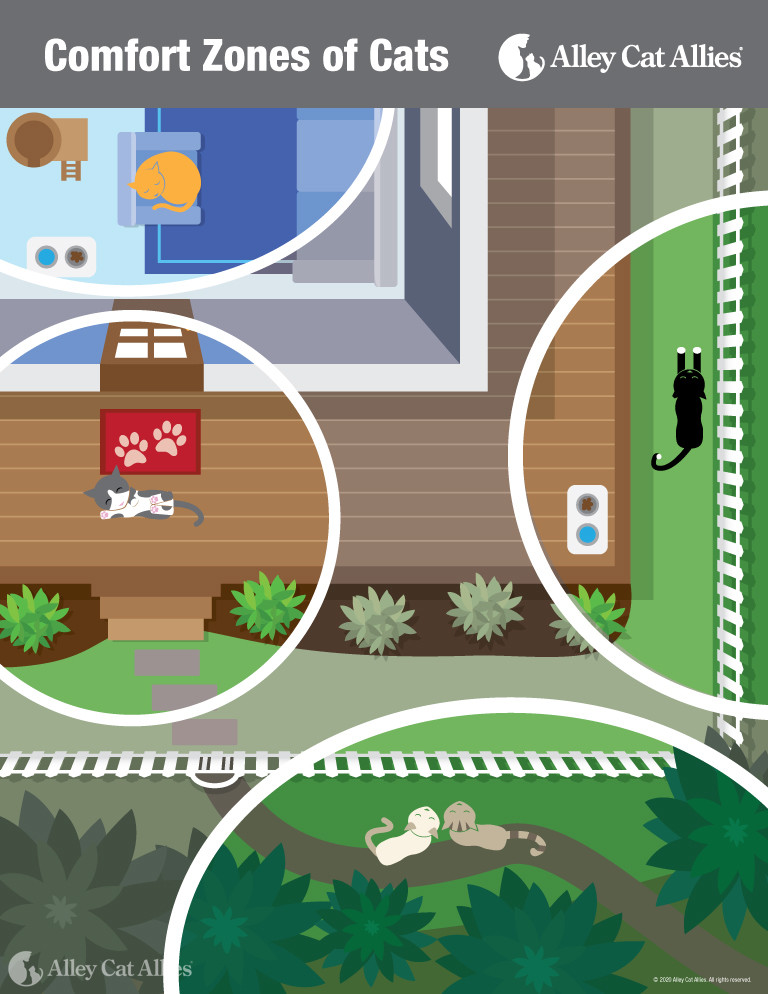A Guide to Interactions Between Cats and Humans
Alley Cat Allies’ “The Cat Socialization Continuum: A Guide to Interactions Between Cats and Humans” will help you understand the many degrees of socialization cats can exhibit and how to apply that knowledge to best care for, help, and protect them.
No matter the environment, from the chill of Iceland to the heat of India, the urban bustle of Hong Kong to the rural plains of Iowa, you’re likely to find a cat. Cats are incredibly adaptable and resilient, and thrive alongside people everywhere we live.
The measure of a cat’s comfort around humans is known as socialization. Each cat falls somewhere along a vast socialization continuum. To best help cats, every advocate, shelter staff member, caregiver, veterinary professional, and official needs to comprehend, respect, and apply this continuum.
Alley Cat Allies created this guide as an easy, accessible, and informative resource. By the time you’ve finished reading, you will know what socialization is, the different possible points on the socialization continuum, and how policies that take cats’ socialization into account are key to saving their lives.
We hope this information helps you better understand the cats in your community and their unique needs.
What is Socialization?
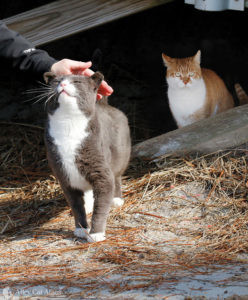
When we say a cat is socialized, we mean she is accustomed to and enjoys companionship with people. To socialize a cat means to gradually acclimate her to human touch, human spaces, and human sights, smells, and sounds. It’s a process that is influenced by many factors of a cat’s life and takes time and effort from compassionate people.
The most socialized cats are those who share our homes, seek our affection, and rely on us for their everyday needs. On the other end, feral cats who are born and live outdoors in our communities and have rarely or never had contact with peopleactively avoid it, evenare unsocialized.
These cats all belong to the same domesticated species, Felis catus. However, domestication and socialization are not the same thing.
How Cats Became Domesticated
Cats have shared our spaces for thousands of years and live alongside us–indoors and outdoors–in every environment we inhabit.
Even so, we’re still learning new things about cats all the time. For example, research has found that cats’ early wild ancestors “self-selected,” meaning they adjusted their own behavior to live closer to humans.
Just as dogs evolved the facial muscles needed to give us “puppy eyes” to appeal to us, the bravest early cats adapted in order to gain something from people. They took courageous steps to make themselves at home around humans so they could take advantage of the plentiful mice and food scraps in their settlements.
In short, cats adapted to living in close quarters with people for easier access to meals and other human resources.
Over a long period of time and many, many generations of early wild cats living closer to people, the cats became domesticated. A species is considered domesticated when it has generationally adapted to live with or among people in order to benefit from them.
By becoming domesticated, these early cats, called Felis silvestris, became an entirely new species: Felis catus.
The Instincts Remain
Domestic cats still have the instincts their wild ancestors had, so they are comfortable outdoors and can survive independently from people. That’s because, for most of their natural history, domestic cats lived totally or partially outdoors and fended for themselves. For example, most ship cats and barn cats lived closely with people but still had to find their own meals.
Domesticated and Socialized are Not the Same
All members of the domestic cat species with whom we live and are most familiar are Felis catus, regardless of how socialized they are.
Though every individual of the Felis catus species is domesticated, not all are socialized. Like cats, other domesticated animals, such as horses, chickens, and pigs, will also become feral if they live away from people for long enough. Domestication happens to a species over generations, while socialization differs with each individual.
Socialization is All About Experience
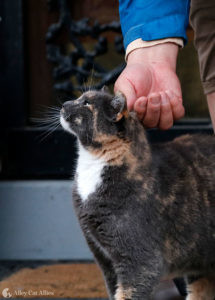 Kittens learn what it means to act like a cat by observing other cats and getting some paws-on experience. Experience is also the only way cats learn to live comfortably with people.
Kittens learn what it means to act like a cat by observing other cats and getting some paws-on experience. Experience is also the only way cats learn to live comfortably with people.
If a cat never interacts with humans, she will grow up unsocialized and be most at home outside, usually in a bonded family with other outdoor cats known as a colony. People and everything associated with them, like voices, footsteps, lawn mowers, or even electric can openers for cat food, will be scary to her.
But cats are individuals. No two cats are alike, and there’s no one way a cat lives, experiences, or interacts with people. That’s why socialization is so much more than two opposite points–socialized or unsocialized–on a single line. There’s a wealth of gray area between those points that represents the many degrees of socialization in cats. Socialization is a continuum.
“Feral” vs “Stray” vs “Pet” Cats
Within the wider socialization continuum, there are three common and recognizable labels: feral, stray, and “pet” cats. Knowing how to distinguish among them will give you a solid idea of how to best help every cat.
A feral cat is an unsocialized outdoor cat who has either never had any physical contact with humans, or human contact has diminished enough over time that she’s no longer accustomed to it. Most feral cats are fearful of people and can’t become a lap cat or live indoors.
Feral cats thrive outdoors and are not reliant on people directly feeding them. They are adept at finding their own meals, from the leftovers people discard to food sources in their natural environment. Sometimes, though, these independent cats may have human caregivers who regularly feed them.
Feral cats are only at home outdoors with their feline families. However, it’s possible to socialize kittens born to feral cats if we handle them at an early enough age. These kittens can then be adopted into indoor homes.
A stray cat is a cat who lived indoors and was socialized to people at some point in her life, but left or lost her home and no longer has regular human contact. A stray cat may be socialized enough to allow people to touch her, but she will become less socialized–or even feral–if she spends too much time without positive interaction with humans.
As cat behavior expert John Bradshaw puts it: “Cats still have three out of four paws firmly planted in the wild, and within only a few generations can easily revert to the independent way of life that was the exclusive preserve of their predecessors some 10,000 years ago.” But if a stray cat is re-introduced to regular human contact, she may become socialized again.
For more on the differences between stray and feral cats, visit alleycat.org/StrayOrFeral.
A “pet” cat, which is what many people call cats who live indoors with human families, are socialized to people and are comfortable being in houses and being touched. This cat may also be an indoor/outdoor cat, meaning she spends time outdoors but still enjoys being or primarily lives indoors and is reliant on people for her food and care.
Community Cats
“Community cat” is an umbrella term that refers to any member of the Felis catus species who is unowned and lives outdoors. Both feral and stray cats are community cats. Community cats have a wide range of behaviors and degrees of socialization, but they generally do not want to live indoors and are unadoptable.
This Guide Will Help You Save Cats
Some cats want to sit in your lap every minute of every day. Some cats live outside and only enjoy limited interaction with the caregivers who feed them. Some cats want nothing to do with people and will avoid all contact. Many cats will weave between those different behaviors over time.
All deserve our protection and respect.
As a society, we have a long history of not showing compassion to less socialized cats. Cats and kittens are still killed in animal shelters every day because too many communities don’t have humane policies that accommodate cats’ differing needs at every degree of socialization.
By understanding socialization, we can successfully advocate for practices and programs that help cats live and thrive in the environments best suited to them.
In this guide, we’ll walk through the wide variety of points on the socialization continuum, the signs of socialization, the factors that determine how socialized a cat will be, and why it all matters. With this knowledge, you can make decisions that protect and improve all cats’ lives.
How Socialization is a Continuum
Socialization in cats isn’t a matter of solid labels, but a fluid state of being. Like the colors of a rainbow, the different degrees of socialization flow into each other and create many in-between areas where cats can reside.
Cats also don’t always stay in a single place on that rainbow in their lifetimes. They can move along the continuum depending on their age, circumstances, and experiences. We’ll explore these factors of socialization later in this guide.
Though there are many gray areas, there are still some basic points along the continuum that can guide you toward the best approach to a cat. The simplest is the “Touch Barrier.”
The Touch Barrier
The easiest way to tell the difference between a socialized and unsocialized cat is whether they’ll let a person touch them. We call the invisible separation between cats who allow touch and cats who will not the “Touch Barrier.”
The concept of the Touch Barrier is attributed to renowned cat expert Joan Miller and the following graphic was adapted from her definition. Watch her discuss the Touch Barrier as part of her presentation, “Cultivating Cool Cats: Handling Felines in the Shelter so They Look and Feel Their Best” at alleycat.org/Videos.
Cats who are inside the Touch Barrier are more socialized to people and often enjoy touch. Cats who are outside the Touch Barrier are more unsocialized and typically avoid touch.
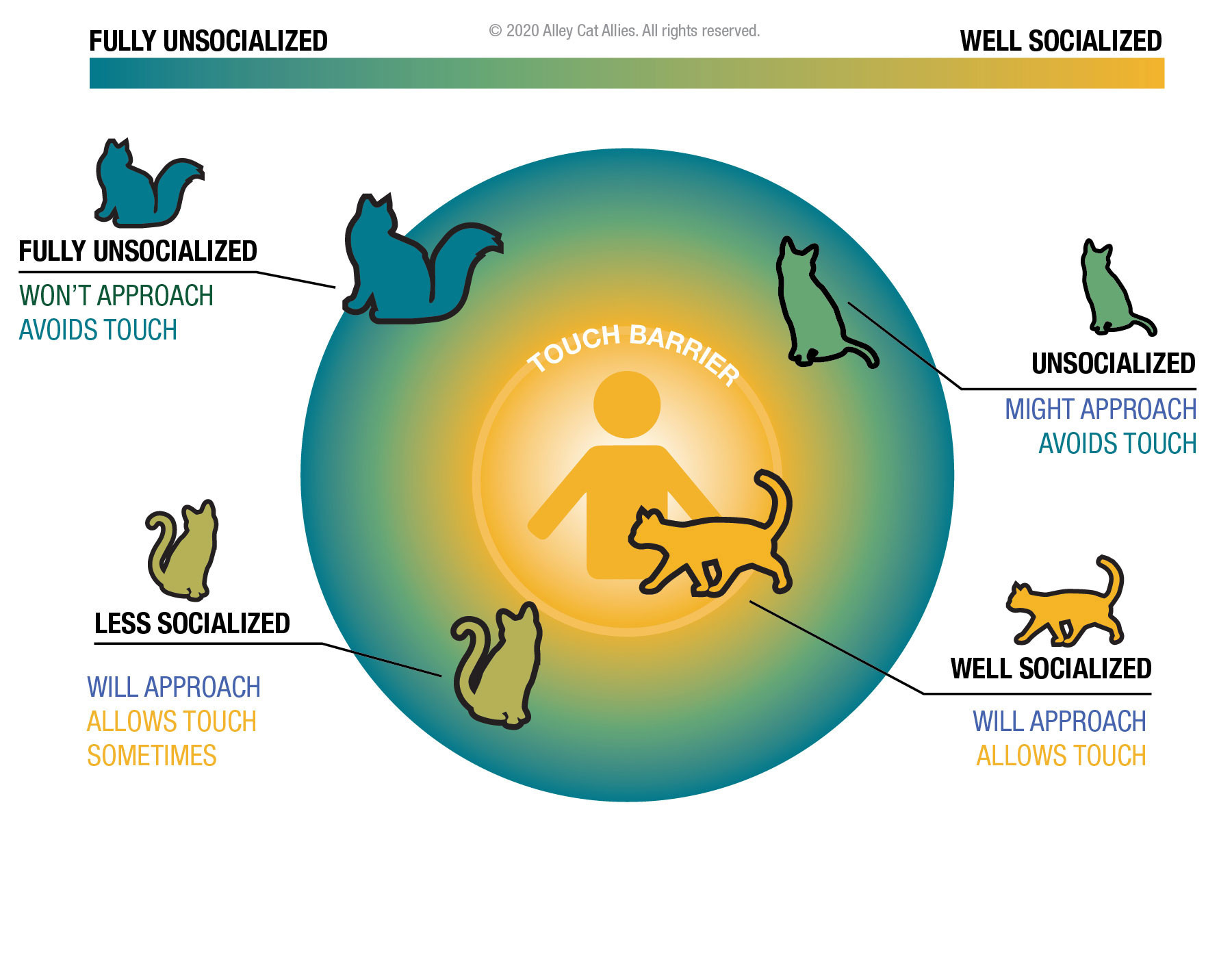
The Comfort Zone
Another thing to consider is a cat’s “Comfort Zone,” or how close a cat can live or spend time with people and stay comfortable. The most socialized cats live indoors with us, while fully unsocialized cats live outdoors and avoid human-populated areas. Many cats live somewhere in between.
Every Cat Has a Story
All cats are unique and have their own stories. That’s where the combination of a cat’s Comfort Zone (where a cat prefers to live in relation to people), and Touch Barrier (if a cat likes to be touched) can get really interesting.
Here are some examples:
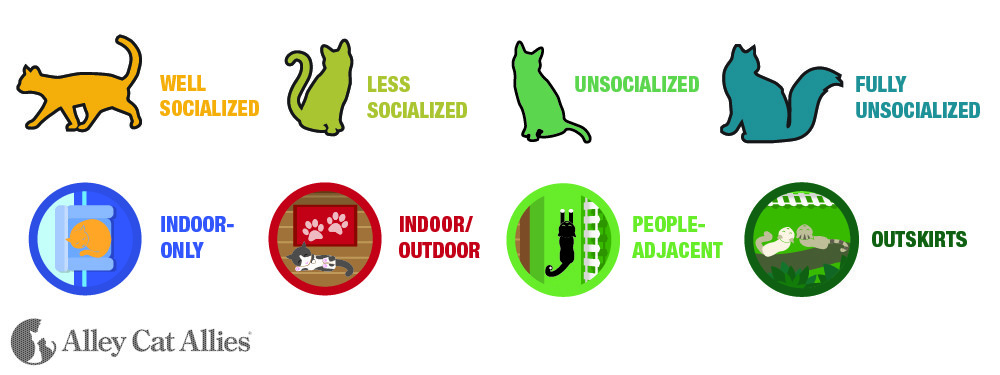
Allie was born indoors. She’s been held, played with, and petted by people since she was less than a week old. Today, she loves to sit on people’s laps and meows for attention all the time.
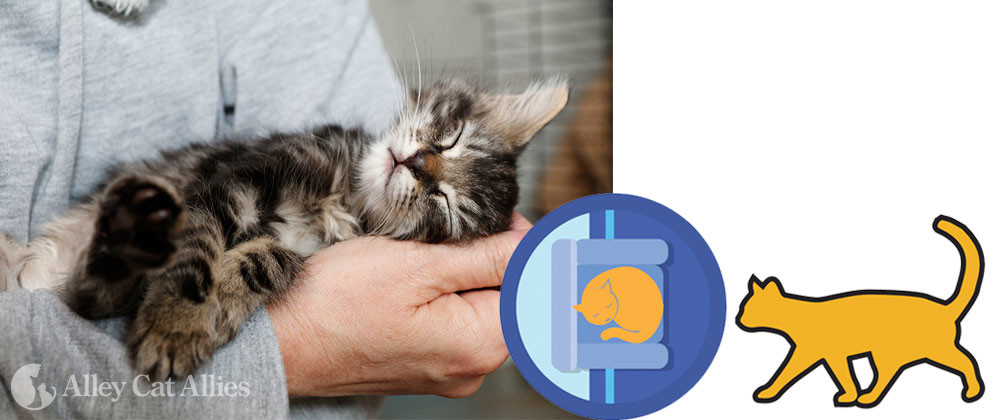
Robin was adopted from a rescue organization after being surrendered from her previous indoor home. She was a little nervous at first but now she’s approaching her new family for affection.
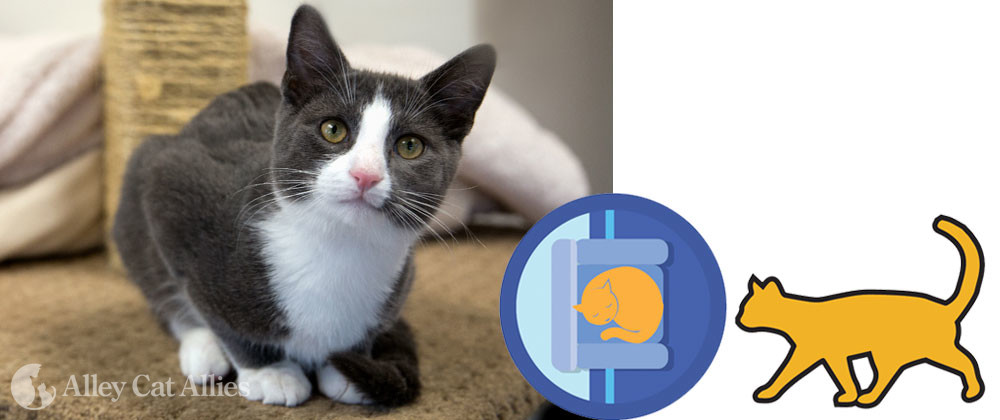
Cliff sleeps and eats indoors and enjoys affection from his family, but he also has access to the outdoors and spends a lot of time there. Sometimes, he’ll bolt when strangers approach him outside.
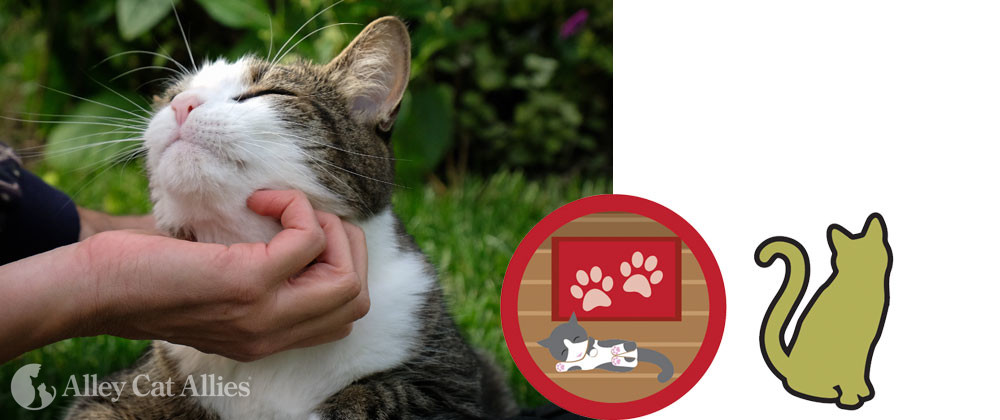
Smokey was born outdoors and is fed every day by an Alley Cat Allies Boardwalk Cats Project® volunteer. She is used to her caregiver and lets him pet her. However, she runs from other people and would be fearful and unhappy living indoors.
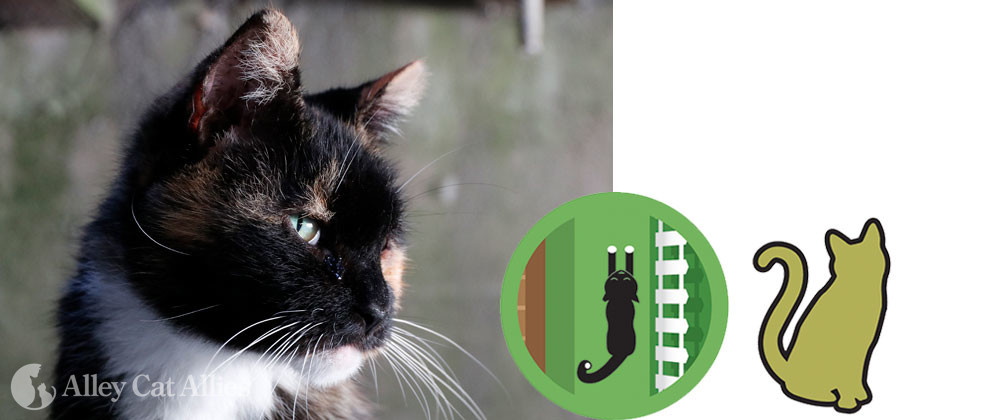
Jay is a community cat who was born outdoors and has a regular caregiver. He’s used to her enough that he won’t run when she comes to feed him, but he avoids her if she tries to get too close or touch him.
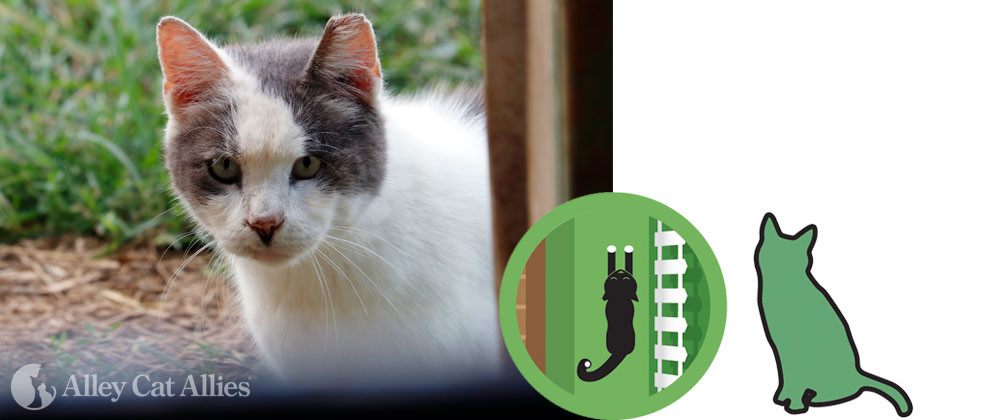
Grace, a community cat, has gotten used to a caregiver coming into her territory to feed her. However, she’ll stay hidden until her caregiver sets down the food and leaves. Only then does she emerge to eat.
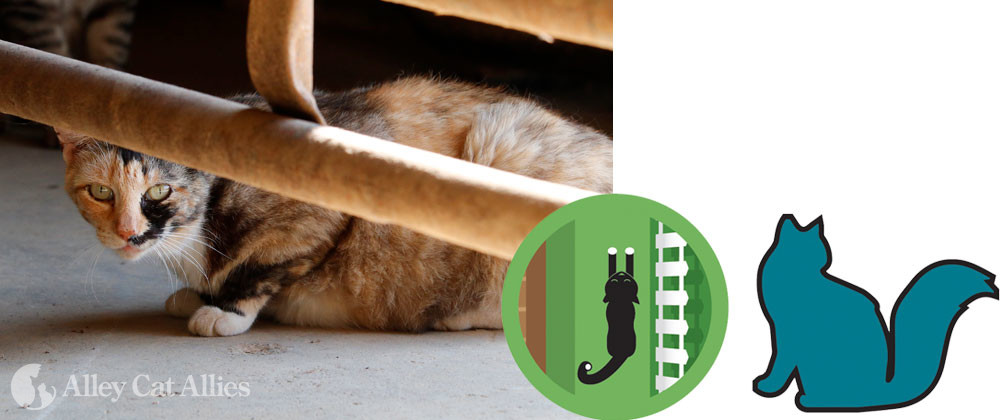
This independent cat lives in the woods beside an apartment complex. He has no caregiver and finds his own food. You’ll only see him at night searching for a meal near the complex (usually from a trash can), and he’ll run if he sees or hears a person too close.
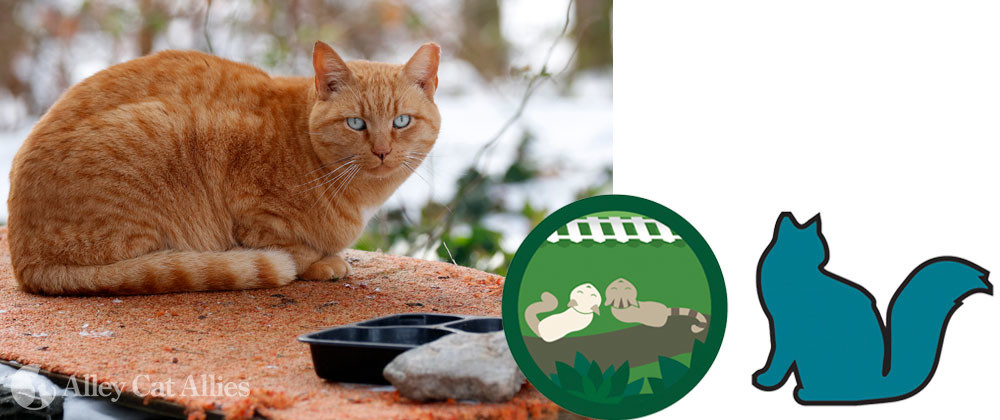
This cat was born outdoors and lives in a forest away from regular human activity. She finds her own food in her natural environment. People are completely unfamiliar and scary to her. In fact, you may not be aware she exists because she’s so good at hiding!
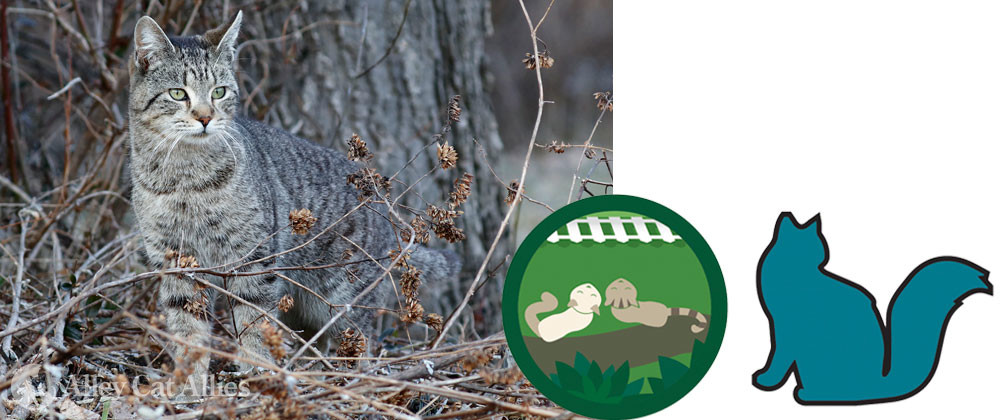
The Signs of Socialization
Both socialized and unsocialized cats have distinct behaviors that will help you figure out where they fall on the socialization continuum. Generally, socialized cats (indoor, indoor/outdoor, and some strays) will approach and show signs that they are comfortable around people. Unsocialized cats (feral, some strays) will not approach and will show signs of discomfort with people.
Remember: Socialized and unsocialized cats can be very difficult to tell apart when they’re in a scary or unfamiliar environment.
A study on socialization of cats in shelters found that when socialized cats were allowed a few days to relax at the shelter and show their true colors, they had unique behaviors that unsocialized cats never displayed around people. This guide will help you recognize them.
To read more about this study and others like it, visit alleycat.org/Research.
Socialized Cat Behaviors
When in close proximity to people, a socialized cat will often:
- Vocalize (chirp, meow)
- Approach
- Allow touch
- Raise her ears regularly
- Raise her tail
- Retain a relaxed posture
- Reach toward a person
- Rub
- Knead
- Play
- Purr
- Groom or shake her body
- Sniff
- Expose her stomach
- Stay visible during the daytime
- Show interest in household sounds
Unsocialized Cat Behaviors
When in close proximity to people, an unsocialized cat will:
- Not vocalize (chirping, meowing)
- Not allow touch
- Flee and hide from an approaching person
- Keep her ears consistently back or flat
- Tightly wrap her tail around her
- Retain an arched or tense posture
- Swipe or lash out at people
- Dilate pupils
- Hiss
- Growl
- Howl
- Bristle fur
- Crouch or crawl
- Not relax around people
- Hide during the daytime
- Show no interest in household sounds
The Factors of Socialization
How socialized a cat is, or how much you can socialize her, depends on many different factors. Knowing these factors will help you determine the best approach for any cat.
Factor One: Age
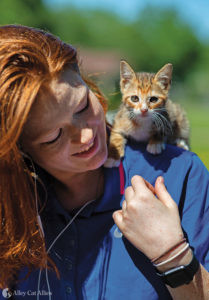 Kittens have a critical window in their development between the ages of 2 and 8 weeks. At 2 weeks old, kittens’ eyes and ears have just opened (they’re closed at birth!) and they are especially observant of their surroundings. For the next few weeks, they learn at a rapid rate and their minds soak in new experiences like a sponge.
Kittens have a critical window in their development between the ages of 2 and 8 weeks. At 2 weeks old, kittens’ eyes and ears have just opened (they’re closed at birth!) and they are especially observant of their surroundings. For the next few weeks, they learn at a rapid rate and their minds soak in new experiences like a sponge.
This critical window is the key to socializing a cat! During this time, introduce kittens to areas and objects throughout your home and handle and play with them regularly. The younger a kitten is handled, the more socialized she will be.
Remember: The critical window closes fast. With every week that passes, a kitten becomes more difficult to socialize.
When kittens are 2 months old and older, socialization gets much more challenging. Cats are creatures of habit who are very attached to their territories and stressed by change. The older they get, the more set they are in their ways and the less you can influence them.
For this reason, Alley Cat Allies does not, in general, recommend trying to socialize a feral cat over 4 months of age. There is a gray area in all of this in which the personality of individual cats comes into play. Between 4 and 8 months of age, if there is time and capacity and if individual kittens are showing meaningful signs of social behavior, the decision may be made to place the kitten in a foster home for socialization. If the kitten does not show signs of socialization within a week or two, it is in her best interest to return her to her colony outdoors.
Community cats are comfortable in their outdoor homes and living indoors around people is frightening. When cats feel confined, it can stress them so much that it harms their health. It’s next to impossible to change their behavior–and that’s okay! They’re fine just as they are, especially with help from humane programs like Trap-Neuter-Return (TNR).
“But I was able to socialize my adult feral cat!”
There are always exceptions to the rule. Most times, though, an adult feral cat can’t be successfully socialized. When it comes to saving as many cats’ lives as possible, time and energy are far better spent ensuring community cats are spayed or neutered and vaccinated as part of a TNR program.
Factor Two: Time with People
A cat has to spend quality time around people in order to be comfortable with people. Obvious, right? The more a cat is handled and the closer she lives near people, especially within her critical window of development, the more socialized she will be. The less a cat is in contact with people, the more unsocialized she will be.
The most socialized cats have lived with people indoors and been handled and played with since they were born. Life without people is completely foreign to them. But keep in in mind that socialization can be fluid, and time is a big reason why.
For example, a stray cat who spent most of her life with humans may approach people at first. But the longer she spends outdoors without regular human contact, the less socialized she will become.
Adult cats who were born outdoors and never spent any time around people will never be socialized. They are feral and will flee when you see them–if you see them at all. Cats who were born outdoors and only start spending time around people in adulthood may get used to a caregiver who regularly feeds them, but they won’t be comfortable living indoors.
However, you can socialize feral kittens if you work with them before they hit 4 months of age. These kittens will be unsocialized at first but, with enough time and handling (if you have the resources to do so), they can become socialized cats who can live indoors and be adopted.
Factor Three: Positive, Neutral, or Negative Interaction
To become socialized, a cat must have positive interactions with people. Meanwhile, negative interactions will damage a cat’s trust in people and her degree of socialization. Neutral interactions will not make a cat your best friend, but they do no harm either.
Positive Interaction
These interactions are the key to a socialized cat. Cats must associate human contact with comfort, food, fun, and safety in order to enjoy the company of people and feel at home indoors.
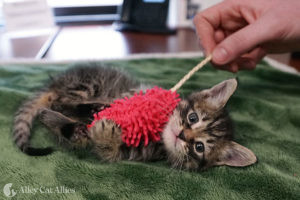 The most important positive interactions include:
The most important positive interactions include:
- Handling, petting, and gentle talking
- Providing food and treats
- Playing together
- Providing an environment with comfortable places to sleep, eat, and jump
Bottom line: Positive interaction is the way to socialize a cat.
The Power of Food
Cats are driven by their instincts, which means access to food is one of the most important things in their world. By feeding your cat, you become the provider she trusts to fulfill her needs.
Food is also how some community cats become more socialized to their caregivers. They start to associate that person with a tasty meal. That doesn’t mean these cats will ever want to live inside, though!
Negative Interaction
If a cat has negative experiences with people, she won’t forget them. The fear instinct is one of cats’ strongest. If they associate human contact with harm, yelling, and threatening movements, they will be far less socialized. This is especially true if the negative experiences occur during a kitten’s critical window of development.
Even socialized cats who live indoors may react to some regular household noises with fear if not acclimated to them properly. For example, a cat may associate the front door opening with loud noises and quick-moving feet and hide every time you have friends over. That’s why it’s so important to expose kittens to as many indoor living experiences as possible and help them associate those experiences with positive things like petting or treats.
Bottom line: Negative interactions contribute to a cat being unsocialized.
Neutral Interaction
Neutral interactions won’t move a cat either way on the socialization continuum. However, that doesn’t mean they aren’t important. Neutral interactions with cats can simply mean coexisting in a shared environment with little contact. Like a neighbor who knows a community cat colony lives nearby but makes no move to interact with them OR call animal control to remove them.
Cats live outdoors, always have and always will. Alley Cat Allies’ mission is to show people that community cats have a valuable place in our society, and that we can live peacefully together.
Bottom line: Neutral interactions don’t affect a cat’s socialization but are a beneficial way for community cats and people to coexist.
Factor Four: Environment and Stress Level
Picture this scenario: A happy, cuddly cat who lives indoors slips past the front door and bolts outside one day. As she wanders along the block, somebody calls animal control to bring her to the local animal shelter. A shelter staff member looks in on the cat when she first arrives–and she’s pressed against the back of her cage and hissing. Because of this behavior, the staff member assumes the cat is feral.
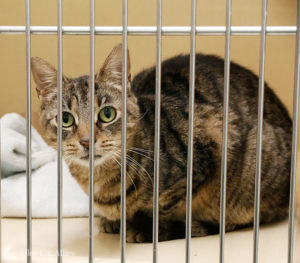 The staff member’s assessment is incorrect and could even be dangerous. Misjudgments like this have put millions of cats’ lives in danger. It can be difficult to distinguish a scared socialized cat from an unsocialized cat, because cats’ fear responses are similar at every degree of socialization.
The staff member’s assessment is incorrect and could even be dangerous. Misjudgments like this have put millions of cats’ lives in danger. It can be difficult to distinguish a scared socialized cat from an unsocialized cat, because cats’ fear responses are similar at every degree of socialization.
Cats have a sensitive sense of smell and hearing, so environments filled with strange scents and loud, unfamiliar sounds terrify them. Shelters especially are a perfect storm of anxiety-inducing stimuli. Even the most socialized cats may start acting in ways that make them appear very unsocialized.
That’s why in stressful environments like shelters, every cat must be soothed with methods like slow approaches, quiet spaces, or calming pheromones and places to hide. Cats need at least a few days to show their true degree of socialization. Otherwise, shelter staff will never know how socialized a cat really is and can’t make the correct decision for her care.
Spay and Neuter Matters
Whether a cat is spayed or neutered can also affect how socialized they appear. Pregnancy and mating are stressful for cats, and they will act accordingly. With their territorial and sexual instinct in hyperdrive, they will yowl, fight, mark, and be generally tense.
An unneutered male cat, even if he has lived indoors with people his entire life, may fight to get outdoors to find a female cat. He likely won’t be a cuddly companion. A pregnant female cat or a mother who has given birth may act more aggressive or avoidant because she is in a natural protective mode over her kittens.
Always spay and neuter cats to ensure they are healthy and free of hormonal influences.
Cats and Fear Response
Cats are naturally cautious animals and are very attached to familiar territories and routines. When they’re taken from what they know and put in an unfamiliar and anxiety-inducing environment, fear and stress take over. Every action and reaction of a cat will then be driven by fear.
Factor Five: Genetics and Breed
While it’s far from a guarantee, a cat’s genetics and breed can affect how easily she can be socialized. Studies have found that kittens born to a friendly and affectionate cat often inherit that temperament.
Some cats are bred for specific personality traits, including friendliness toward people and comfort with being handled. Cat breeds like Sphynx, Ragdoll, Burmese, and Siamese are bred with human companionship in mind.
However, these cats are still not born socialized. All the above factors combined are what really determine where they fall on the socialization continuum. Genetics and breed may just give some cats a paw up.
Factor Six: Personality
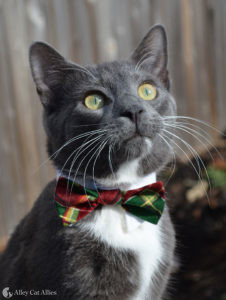 A cat is not a person, but she is still an individual. Sometimes, how friendly they are is simply part of their personality.
A cat is not a person, but she is still an individual. Sometimes, how friendly they are is simply part of their personality.
Picture this scenario: Two kittens are born from the same mother in the same indoor home and are handled the same way by people. One kitten grows up to love being held and sit in laps. The other grows up feisty and always on the move, with no time to cuddle or be picked up. Both are socialized to people, but their individual personalities determined how cuddly–or not–they are.
Another example: A community cat grows more comfortable over time around a caregiver who feeds him every day. He eventually allows the caregiver to approach and even touch him. Meanwhile, other cats in his colony who have been fed by the caregiver just as long never become comfortable enough to allow touch.
This is another reason why socialization is so fluid. Often, it just comes down to the individual cat.
Turn Knowledge into Lifesaving Action
With a greater understanding of socialization, caregivers, advocates, veterinarians, animal control officers, and shelter professionals can develop policies and programs to meet cats’ unique needs–no matter where they fall on the socialization continuum.
Trap-Neuter-Return (TNR) Protects Unsocialized Cats
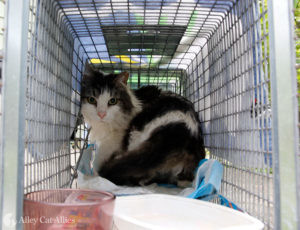 TNR, the only humane and effective approach to community cats, takes cats’ socialization into account to successfully save their lives.
TNR, the only humane and effective approach to community cats, takes cats’ socialization into account to successfully save their lives.
Remember: Even friendly socialized cats run the risk of being killed in shelters that don’t have the space, resources, and programs to protect them. Utilize local cat rescue resources and practice TNR rather than bringing cats to a shelter.
TNR is the proven way to help unsocialized outdoor cats. These cats do not want to live indoors and are unadoptable. Even cats who are more socialized may revert to feral behavior when they are confined in the shelter environment, which is very stressful to them. That means in far too many shelters, community cats are highly likely to be killed.
TNR ensures community cats are not impounded in shelters, but instead spayed or neutered and allowed to thrive in their outdoor homes.
Keep in mind: More socialized community cats and kittens should also be helped through TNR unless you have the ample time and resources it takes to foster and adopt them. They are used to being outdoors and will thrive there.
Trap-Neuter-Return (TNR)
TNR is the process of humanely trapping, spaying or neutering, vaccinating, often microchipping, eartipping (the universal sign of a spayed or neutered and vaccinated outdoor cat) and returning community cats to their outdoor homes.
What Animal Shelters Can Do
Every year, thousands upon thousands of socialized and unsocialized cats enter the shelter system. Without humane policies that take the socialization continuum into consideration, far too many of these cats are killed. It doesn’t have to be that way.
By understanding and respecting socialization, shelter professionals and animal control officers can make lifesaving decisions for every cat.
Shelters must develop programs and policies that protect cats of every degree of socialization. Only cats found to be socialized and acclimated to living indoors should be adopted into a home.
Cats toward the unsocialized, or feral, end of the continuum will never be comfortable living with people and are unadoptable as an indoor cat. Rather than killing these cats, shelters should adopt or support a TNR, Shelter-Neuter-Return (SNR), or Return-to-Field (RTF) program. These programs move community cats swiftly out of the shelter and back to the outdoor homes where they belong–saving their lives as well as shelter resources and taxpayer dollars.
To make the right decision, though, shelter staff first have to figure out which cats are socialized or unsocialized. That’s where a socialization assessment comes in. The assessment helps determine where a cat falls on the socialization continuum based on her behavior.
How It Works:
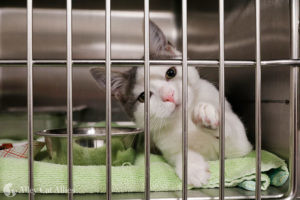 Since cats may not show their true degree of socialization right away in the stressful shelter environment, the assessment only starts after a cat has spent at least one night in the shelter to settle. Then, it takes place over the course of at least three days (fewer if a cat immediately shows signs of being socialized).
Since cats may not show their true degree of socialization right away in the stressful shelter environment, the assessment only starts after a cat has spent at least one night in the shelter to settle. Then, it takes place over the course of at least three days (fewer if a cat immediately shows signs of being socialized).
Shelter staff or volunteers test each cat with different stimuli and watch for “checklist behaviors” that show they are socialized. If cats display these checklist behaviors over time, they are marked as “Extremely/Likely to be Socialized” and put up for adoption or into a foster home.
If cats show none of the checklist behaviors, they are marked as “unsocialized” and are referred to a TNR program.
The following socialization assessment model was adapted from a study published in Animals, an international peer-reviewed open access journal. To read more about this study, visit alleycat.org/Research.
Examples of tests for socialized cat behaviors include:
- Greeting without opening the cage. Immediately or over time, a socialized cat may approach the greeter, stay where they are with relaxed posture, or vocalize (meow) in response. An unsocialized cat will consistently move away from the greeter, watch the greeter carefully, have tense posture, or hiss or growl.
- Putting a hand on the cage door or cracking the door open. A socialized cat may eventually approach the staff member, or at least be less guarded, having a relaxed posture and ears up. An unsocialized cat will not approach and may shy away, may hiss or growl, and will watch the staff member closely.
- Introducing toys and play. Socialized cats will pay attention to the toys and play with them, showing they can relax and have fun in the presence of a person. An unsocialized cat may not play and is more likely to just keep wary eyes on the staff member.
- Touching cats with a wand or other tool. Socialized cats may enjoy the touch, sniff at or attempt to play with the wand, or just calmly allow the contact. An unsocialized cat will consistently move away from or stiffen at the touch and may hiss or growl.
After three days of these tests, shelter staff will have a clearer idea of whether a cat is socialized. Then they will know how to proceed to provide the best possible outcome for that cat.
To help more socialized cats get comfortable and show their true colors, shelter professionals can also adopt practices that are soothing and positive for cats. These methods can include enrichment activities like play times with toys to distract a cat from the scary shelter environment. It’s also helpful to appeal to cats’ senses with tactics like spraying calming pheromones.
Remember: Cats thrive with predictability. Create and stick to a consistent schedule for cats. They’ll be most comfortable and confident if a shelter feeds, cleans, interacts with them, and turns the lights out at the same time every day.
A Blueprint for Change
Help your local animal shelter make humane changes to save cats, socialized or unsocialized. Alley Cat Allies has a guide to shelter transformation at alleycat.org/Transform.
What Veterinary Professionals Can Do
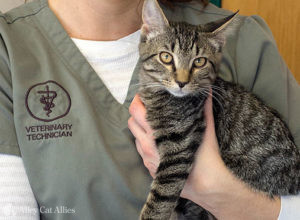 Veterinary professionals can keep themselves and their patients comfortable and safe by adjusting their approach based on how socialized a cat is. This is especially important as veterinarians carry out the “Neuter” stage of TNR, but it is a good rule of thumb for all of their feline clients.
Veterinary professionals can keep themselves and their patients comfortable and safe by adjusting their approach based on how socialized a cat is. This is especially important as veterinarians carry out the “Neuter” stage of TNR, but it is a good rule of thumb for all of their feline clients.
Veterinarians should always keep unsocialized cats in their traps until they’re under anesthesia. Otherwise, they will struggle and strike if handled. Once the cats are unconscious, they can be removed from their traps to be spayed or neutered, vaccinated, microchipped, and eartipped (the removal of approximately one centimeter of the tip of a cat’s left ear; the universal sign of a neutered and vaccinated cat). The cats should then be returned to the same traps they were brought in to recover.
Because unsocialized cats are extremely stressed in a veterinary environment, Alley Cat Allies recommends returning them to their outdoor homes as soon as they’re ready, which is often within one day of surgery.
Learn more about surgery protocols for unsocialized cats at alleycat.org/Veterinarian.
Even for the most socialized cats, the strange smells, sounds, and touches of a veterinary visit can be very scary. Veterinarians should adopt methods that tap into cats’ instincts to help them relax. Some examples include approaching cats slowly, playing calming music, providing treats, spraying relaxing pheromones, and dividing waiting areas so cats can stay separate from noisy dogs. Veterinarians can also examine the cat where the cat feels most comfortable, like inside her carrier, or use towels during the exam to allow the cat to feel hidden.
Fear Free, a certification program, exists to show veterinary professionals and other people who work with animals how to utilize the above methods to increase cats’ comfort level.
What Advocates Can Do
By knowing the signs and factors of socialization, you’ll know how to help any cat who needs you.
Remember: No matter where they fall on the socialization continuum, don’t take cats to animal shelters unless you are sure the shelter has lifesaving programs needed to help them. For example, Shelter-Neuter-Return (SNR) is a program in which cats are taken to the shelter so shelter staff can have them spayed or neutered, vaccinated, eartipped, and returned to their outdoor homes.
How to Help Unsocialized or Feral Cats
If you believe a cat is unsocialized, you should carry out TNR so she can live and thrive in her outdoor home. Alley Cat Allies has a comprehensive guide to TNR at alleycat.org/TNRGuide.
How to Help Socialized Stray Cats
If you believe a cat is a socialized stray, you can take her to a veterinarian to have her scanned for a microchip right away. Her family may be missing her. Then, try putting up flyers with the cat’s photo around the community and posting about her on social media.
If you don’t have a photo on hand, it is helpful to know the exact terms to describe the cat and her unique physical features, like markings and fur color, so you can relay them. Alley Cat Allies’ Cat Identification Guide can help you do so. Find it at alleycat.org/CatIDGuide.
If you can’t find the cat’s owner, and keep in mind she may not have one even if she is socialized, you can bring her to a rescue group or foster home, take her in yourself, or practice TNR. In many cases the outdoors may be home to her, so TNR is always a great option! No matter the decision, always make sure the cat is spayed or neutered, vaccinated, and microchipped.
Remember: Even a socialized stray cat may be more comfortable outdoors than indoors. TNR is always a lifesaving approach and stray cats can and should be included in TNR programs like any other community cat. As an individual, you may choose to try socializing a friendlier stray. However, when it comes to general policy for stray cats, TNR should always be first on the list. Otherwise these cats may be taken to and remain in animal shelters, which endanger their lives and pull resources from adoptable cats.
How to Help Kittens
If you find kittens outdoors, your next steps depend on the kittens’ ages and if their mother cat is around. Make sure all kittens are spayed or neutered, vaccinated, and microchipped as soon as they are 8 weeks old and weigh at least 2 pounds. Don’t forget to spay mom too.
You can learn more with our Finding Kittens Outdoors resource.
Bottom line: TNR is the humane approach for cats AND kittens. Only bring kittens indoors to foster and adopt if you have the time and resources to do so.
Respect Cats’ Nature to Save Their Lives
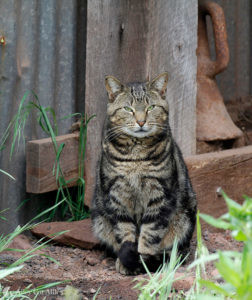 The socialization continuum is fluid, but a cat who is completely unsocialized will almost never be able to live comfortably with people. Such cats can only thrive outdoors. Likewise, a socialized cat who has lived indoors all her life best thrives by staying indoors. Respecting cats’ socialization ensures they stay in environments where they can live long, healthy lives.
The socialization continuum is fluid, but a cat who is completely unsocialized will almost never be able to live comfortably with people. Such cats can only thrive outdoors. Likewise, a socialized cat who has lived indoors all her life best thrives by staying indoors. Respecting cats’ socialization ensures they stay in environments where they can live long, healthy lives.
Helpful Resources
Feral Friends Network
To find advocates and rescues in your area to help with all things cat, including kitten care and TNR assistance, visit alleycat.org/FeralFriends.
The Alley Cat Allies Cat Help Desk
If you need advice or assistance, contact us through our Cat Help Desk online form at alleycat.org/GetHelp.
Alley Cat Allies’ Kitten Resources
Find our guides on determining a kitten’s age, caring for and socializing young kittens, what to do if you find kittens outdoors, and more at alleycat.org/Kittens.
Feral and Stray CatsAn Important Difference
Learn more about the key differences between feral and stray cats, and their degrees of socialization, at alleycat.org/StrayOrFeral.
Trap-Neuter-Return (TNR)
Find our in-depth information on TNR, the only humane and effective approach to community cats, and how it saves cats’ lives and improves communities by visiting alleycat.org/TNR.
The Natural History of the Cat
Dive further into the history of cats, and how it influences their relationships with people today, at alleycat.org/CatHistory.
Important Studies about Cats
Find our collection of important research and studies relating to cats by visiting alleycat.org/Research.


